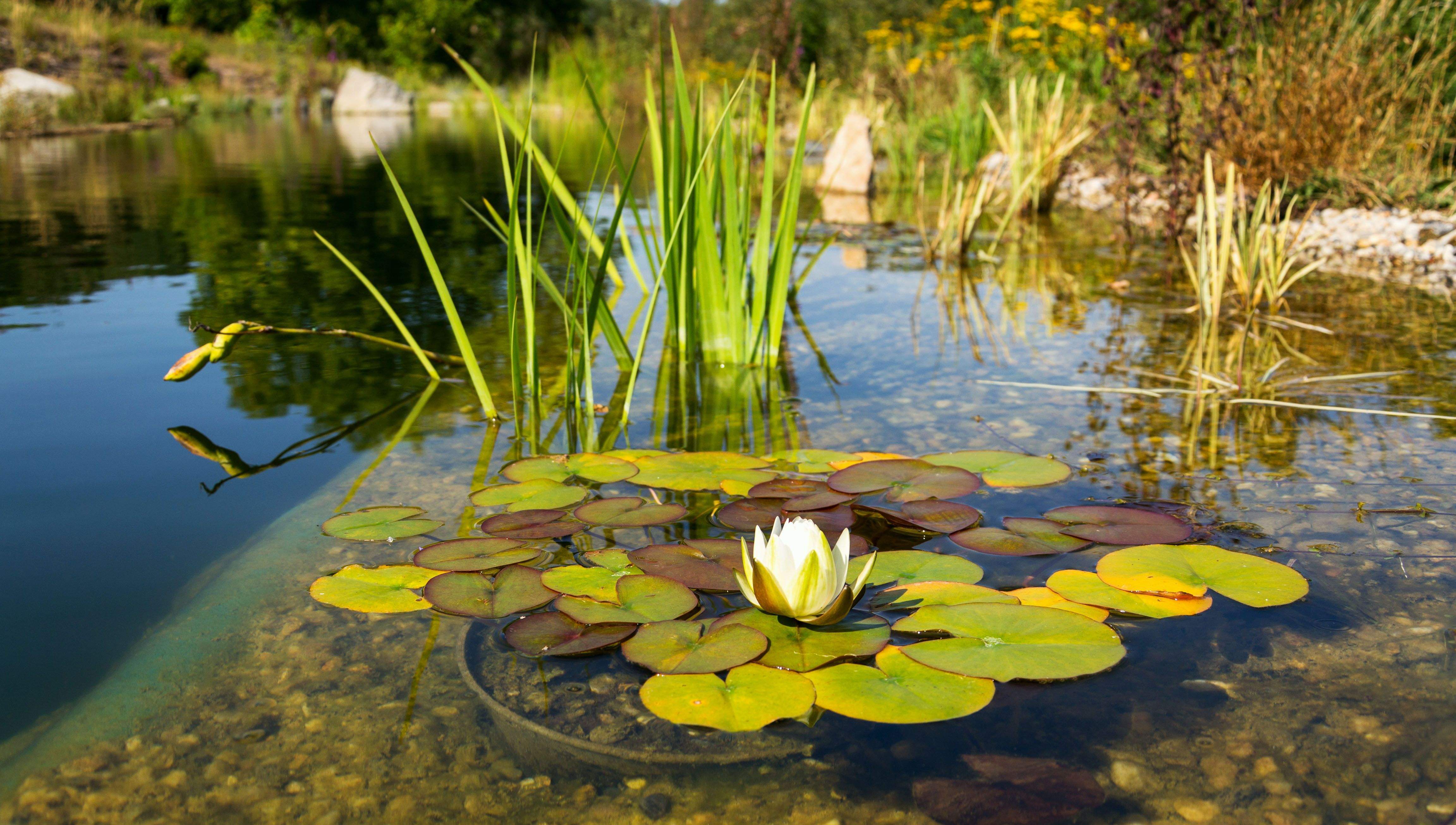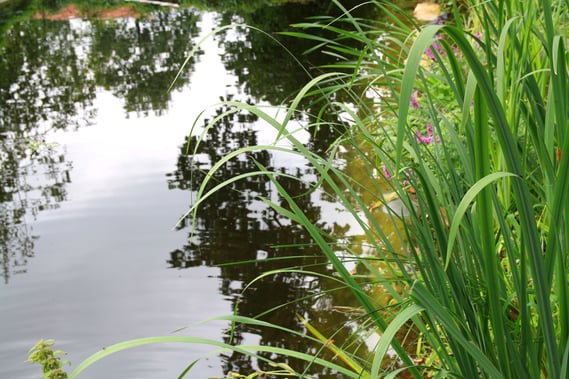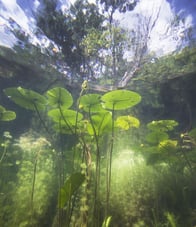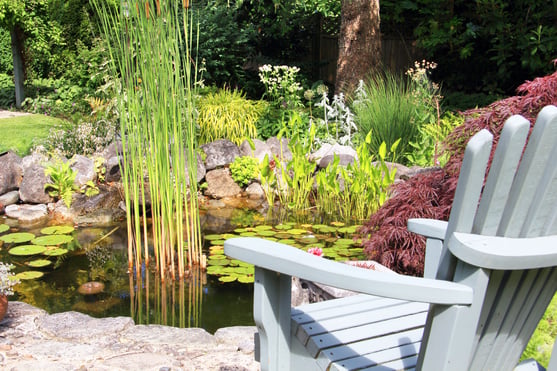What is a Natural Pool? Filtration, Costs, and Pros and Cons
September 4th, 2019
6 min read
By Jason Hughes

Most people work hard to keep their pools from turning green.
Others don’t mind it. In fact, they’ll dive in for a swim when the pool is as green as a swamp.
Why?
That swampy green color is intentional and it’s actually keeping the pool clean.
It might sound strange at first, but this is what many refer to as a natural pool.
At River Pools, we specialize in manufacturing fiberglass swimming pools and we are also experts on inground pool maintenance. In this article, we’ll fill you in on what natural pools are, how they work, and why some people opt for an organic system over a chlorinated one.
Let’s start by explaining what a natural pool is.

What is a natural pool?
Natural pools are also known as eco pools or organic pools because they use natural elements to keep the water clean and safe for swimming.
With a natural pool, rocks and plants are used to keep the water healthy and free of bacteria and algae (rather than chlorine, UV sanitation, or a salt chlorinator). They often have a greenish tint, but they can be clear like a traditional swimming pool.
This system of using plants and rocks to clean the water is known as a biofilter, and it uses the same cleaning methods that are found in nature.
A natural pool might be a good choice for anyone who wants their swimming pool to blend in with the natural environment as well as anyone who wants to avoid using chemicals in their pool.
What is a biofilter?
A biofilter uses a natural system of aquatic plants, rocks, and gravel to cleanse the water in a natural pool. The zone where the water filters through these plants is actually separate from the area where you would swim (meaning you won’t come out of the pool covered in seaweed).
Typically, you would have space off to the side of your pool (or on multiple sides) where the water can be circulated through the plants and gravel before returning back into the main pool. The area with plants and rocks that cleans the water is often referred to as the regeneration zone.
We don’t recommend swimming in the regeneration zone though, even if the plants, rocks, and wildlife don’t bother you (yes, the regeneration zone can attract bugs, frogs, and other creatures).
Which types of plants are in a biofilter or regeneration zone?

A swimming pool’s biofilter requires special aquatic plants that thrive in wet environments, like water lilies or cattails. These plants help to absorb bacteria, phosphates, germs, and harmful impurities, and they oxygenate the water in the process.
For more in-depth information on how natural pools work, check out this great guide from Pool Center.
Can you use a biofilter on any swimming pool?
It’s possible that you can use a biofilter system on any swimming pool, but it’s going to require heavy modification.
If you’re still shopping around for an inground pool and you already know that you want a natural pool, you have an advantage.
At this stage, you can plan your coping, patio, and finishing touches around the natural pool design which includes the regeneration zone/biofilter (the area with plants and rocks that keeps the water clean).
If you have an existing swimming pool, you’re probably going to have to remove a lot of the work you’ve already done to integrate the biofilter. This typically means tearing out your patio and coping and doing a lot of digging.
Caution: Before you take any steps, double check with your pool builder or installer to find out if and how you can modify your pool into a natural pool.
We want to clarify that not all natural pools are the same. In fact, almost every natural pool is unique in the number and types of plants it has, the regeneration zone placement, and water circulation methods.
Many include the plants around the edges of the pool or even in the swimming zone rather than in a designated, separate regeneration area. How you choose to construct your natural pool or modify your swimming pool will depend on your preferences and the recommendations of your contractor.
Can you use a biofilter on a fiberglass pool?
As we mentioned above, almost any pool can be made into a natural/organic pool, and a fiberglass pool would make a great option for this type of system.
Why?
Overall, natural pools are good at eliminating algae, but having a fiberglass pool can reduce the amount of algae even more. The smooth surface, also known as the gelcoat, resists algae growth more than any other inground pool surface and can contribute to keeping your pool clean without chemicals.
How much does a natural pool cost?
In general, building a natural pool will cost more than it would to build a traditional inground pool, with prices starting at around $50k. The more elaborate you get with plants, rocks, waterfalls, etc. and the bigger the pool is, the more you can expect to pay for your natural pool.
Why is it more expensive?
The regeneration zone/biofilter takes up a lot of space and is often about the same size as the swimming area. This makes it much more expensive, especially if you’re looking to have a large area just for swimming.
Keep in mind that most swimming pools are chlorinated pools and not all pool builders specialize in organic systems. If you really want a natural pool, you’ll need a builder who specializes in this type of system, regardless of whether they design and build it from scratch or use an existing pool. Because it is a specialized product, your contractor may charge a premium price.
However, not all pools are the same and not all pools cost the same. That rule applies to natural pools, too.

How much does it cost to modify a chlorinated pool into an organic pool?
The answer is it depends because it's difficult to provide a definitive price across all projects. However, we can help you figure out the costs by breaking down some of the needs of your natural pool project.
If you have an existing inground pool and you want to modify it into an organic pool, here are the main costs that you need to consider:
- Tearing out and replacing the coping and patio ($8.00 and up per square foot)
- Building the regeneration zone (about the same size as your current pool)
- Purchasing rocks, gravel, aquatic plants, etc.
- Modifying your water circulation system (if necessary) to go through the regeneration zone
It’s possible that you may have only a few of these expenses and it’s also possible that you will have more, depending on what you have in mind.
Important: Because a natural pool demands greater space requirements, it may not be the best option for very small backyards.
Natural Pool Maintenance
Since natural pools use little to no chemicals, maintenance will be slightly different from a traditional swimming pool. To start, you’ll need to maintain the water levels with your garden hose, like you would with a regular pool.
You might have to do this more often with a natural pool because the plants increase the evaporation rate. This can run up your water bill over time, so keep this in mind when considering maintenance costs.
As far as regular maintenance, your natural pool will require brushing and skimming about once a week.
The regeneration zone, on the other hand, will require much more work. To care for the regeneration zone/biofilter, you need to trim the plants and clear the floor of dead leaves, sticks, and any other debris that shouldn’t be there. You would do this on a monthly or bimonthly basis.
Keep in mind that if you live in a very cold climate, your aquatic plants may freeze during the winter and may need to be replaced come springtime.
Natural Pools Review: Pros and Cons
Now that you know what a natural pool is and how it works, take a look at this quick recap of the natural pools pros and cons:
Pros:
- Natural/organic pools use very few to no chemicals
- They blend in with the surrounding nature
- They are eco friendly
Cons:
- They’re often a swampy green color
- They require more space
- You have to keep up with the plants (taking care of the regeneration zone is like having an underwater garden)
- They’re often more expensive to build
A natural pool is a good choice if you prefer not to use chemicals and if you like the look of a natural pond. However, it may not be the best option if you're not big on gardening or if you prefer the clear, blue look of a traditional pool. It may not be the most affordable option either if you're on a strict budget.
Have we answered all of your questions about natural pools? Let us know in the comments below.
At River Pools, we manufacture world-class fiberglass swimming pools for installation across North America.. Take a look at our models and visit our gallery to see what our pools look like. We have designs of all shapes and sizes with popular built-in features like tanning ledges, benches, and even spas.
Want to know how much a high-quality fiberglass pool would cost you? Try out our pool pricing calculator today or contact us directly for a custom quote.
If you're still in the learning stages of your pool buying journey, be sure to download our free ebook below explaining the key differences between the three main inground pool types.
Up Next:
Inground Pool Shopping: Can You Buy a Pool Online?
DIY Inground Pools: Costs, Types, and Problems to Consider
Inground Swimming Pool Maintenance Costs: Chemicals, Electricity, and More
Editor's Note: This article was originally written by Jason Hughes on August 23, 2019. Any opinions expressed are those of the author. Any prices referenced were based on information that was readily available at the time.
River Pools is a brand of inground fiberglass pools produced in a manufacturing facility in Fortville, IN. While our expertise is in manufacturing fiberglass pools, we have access to a network of installers with expertise relating to project design, installation, and pool service. We often tap into this knowledge base and share information freely with homeowners, just like you, considering installing a swimming pool in your backyard.
Jason Hughes is a partner at River Pools Virginia, a fiberglass pool installation company based in Warsaw, Virginia. With over 20 years of hands-on experience, Jason has dedicated his career to helping families create beautiful, functional backyards while ensuring every fiberglass pool installation meets the highest standards of quality and safety. In addition to his work with homeowners, Jason serves as a GENESIS instructor with the Pool & Hot Tub Alliance (PHTA), where he teaches fiberglass pool installation best practices to pool professionals across the country. Whether he’s on a job site or leading a training session, Jason is passionate about raising the bar for fiberglass pool installations and helping families make confident, informed decisions as they transform their outdoor spaces.

